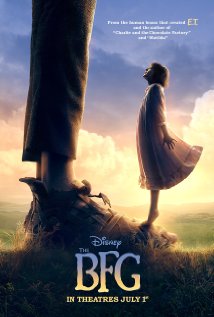 It’s easy to see why filmmakers are drawn to Roald Dahl’s work. He liked placing his stories in our world while adding something most definitely not from our world, with several of his stories coming with a new language. “The BFG” hits everything on the Dahl checklist, but it has trouble getting out of second gear. It’s sweet, it’s beautifully shot, and it sports another fine performance from Mark Rylance (who, last time he worked with “BFG” director Steven Spielberg, won an Oscar for his work in “Bridge of Spies”), but let’s point out the elephant in the room, shall we? Wes Anderson wrecked the curve for Roald Dahl adaptations with his stop-motion masterpiece “Fantastic Mr. Fox.” Following in that movie’s footsteps, even seven years later and multiple generations of technological advancement – something that is clearly prioritized here – “The BFG” didn’t have a prayer.
It’s easy to see why filmmakers are drawn to Roald Dahl’s work. He liked placing his stories in our world while adding something most definitely not from our world, with several of his stories coming with a new language. “The BFG” hits everything on the Dahl checklist, but it has trouble getting out of second gear. It’s sweet, it’s beautifully shot, and it sports another fine performance from Mark Rylance (who, last time he worked with “BFG” director Steven Spielberg, won an Oscar for his work in “Bridge of Spies”), but let’s point out the elephant in the room, shall we? Wes Anderson wrecked the curve for Roald Dahl adaptations with his stop-motion masterpiece “Fantastic Mr. Fox.” Following in that movie’s footsteps, even seven years later and multiple generations of technological advancement – something that is clearly prioritized here – “The BFG” didn’t have a prayer.
Sophie (Ruby Barnhill) lives in a London orphanage at a time that is at first undetermined, but we later learn is the early 1980s (Dahl’s book was released in 1982). She has trouble sleeping, and it is on a sleepless night that she sees a giant walking the streets. The giant (Rylance) sees that he’s been spotted and, out of concern that she will tell the authorities and make things difficult for him, he snatches Sophie and takes her to his home in a faraway land. Unlike the giants he lives with, he has no intentions of hurting her (the others love eating children, and would devour her on sight), and he even takes her as he goes to work catching dreams. The other giants are much larger and meaner than Sophie’s giant – whom she calls BFG after he remarked that he’d like to known as the Big Friendly Giant – and they bully him relentlessly. Sophie encourages BFG to stand up for himself, and comes up with a plan to put the giants in their place.
“The BFG” has an alarming number of lowbrow moments for a Spielberg film, particularly when it comes to bathroom humor. The toilet jokes equate to two scenes’ worth, but they go a long way. In hindsight, those scenes put the Fizzy Lifting Drink scene in “Willie Wonka and the Chocolate Factory” into context. For as next-level as Dahl’s work was, there was clearly a juvenile sensibility running through it all at the same time. Never is that more prevalent than it is here.
Spielberg seems to be approaching the visuals in a manner similar to how Peter Jackson approached the “Hobbit” films. In the scenes where the majority of characters were of the motion capture variety, he went for the tracking shot in order to earn style points. The first one is nice (Hide, Sophie, hide!), but the second one is better. Think of the final tracking shot in “Children of Men,” with giants, and you’re close. The shot with the cat (you’ll know it when you see it) is arguably the movie’s finest moment, and it’s a throwaway shot. The film could have used more of them.
Ruby Barnhill looks like Molly Ringwald just before entering middle school. This makes her likable to anyone who ever gave a damn about Molly Ringwald, but that goodwill turns to pity once you realize that Barnhill spent most of the movie interacting with people on cranes holding a giant X in front of a green screen. If she seems a bit inconsistent, it’s because this is her first film and her second acting credit, and the other acting credit definitely didn’t involve CGI. Rylance has no experience with motion capture either, but then again, he’s a master thespian, and not about to turn 12; experience was clearly on his side, and he delivers the goods.
The most impressive performance here comes from Penelope Wilton, who plays the Queen of England, and finds dignity even in the most undignified moments. Rebecca Hall is here as well, though she only has a handful of lines. Perhaps she was a fan of the book as a child. It came out the year she was born, after all.
Steven Spielberg has a laundry list of signature visual moments one could cull from his films, but what made his work so endearing to people were the stories he told. “The BFG” seems to have his priorities in reverse, where he’s all about making the most impressive motion capture film to date (he’s bragged about this to the press). And maybe he has made the best motion capture film to date, but who cares about that? There is a difference between game-changing visuals, and ‘better than anyone has done to this point’ visuals, and “The BFG” is clearly in the latter category. It’s a perfectly pleasant movie, but it’s not unreasonable to expect more from Steven Spielberg than something perfectly pleasant.
 (3 / 5)
(3 / 5)
This review originally ran June 30, 2016 on Bullz-Eye.com.



